|
Airport Infrastructure Development - Safety - Security- Challenges in Africa
 Profile of GCAA Profile of GCAA |
.Incorporation of the GCAA: Established to give effect to the Chigaco Convention; Regulate and Manage Air Transport and Navigation Route Facilities for Safety, Regularity and Efficiency of Air Transport in The Gambia
.By Transfer of Assets Order Legal Notice No. 7 of 1991, the assets and liabilities of the former Dept. of Civil Aviation was transferred to the GCAA
.The GCAA was also charged with the Operation and Management of Banjul International Airport, Provision of navigational facilities and the management of Air Traffic services; and Regulation of air transport so as to ensure its safety, security, efficiency, and regularity in The Gambia.
.The GCAA now operates under an MOU signed with th GoTG with set minimum performance targets.
 GCAA STRUCTURE GCAA STRUCTURE |
see graph
 MAJOR CHALLENGES MAJOR CHALLENGES |
.Sub-standard airport infrastructure;
.Inadequate financial resources;
.Poor, unreliable, and inadequate facilities for navigation and air traffic services;
.Lowe traffic levels and heavy reliance on highly volatile seasonal tourism;
.Insufficient legal authority to exercise its mandate to give full effect to the Chicago Convention;
.Undeveloped local air line industry; etc
 PASSENGER MOVEMENTS: 1966 - 1999 PASSENGER MOVEMENTS: 1966 - 1999 |
see graph
 ANNUAL PASSENGER THROUGHPUT - 1990 - 1999 ANNUAL PASSENGER THROUGHPUT - 1990 - 1999 |
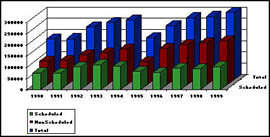

(click on image to enlarge 41Ko)
 CARGO THROUGHPUT - 1990 - 1999 CARGO THROUGHPUT - 1990 - 1999 |
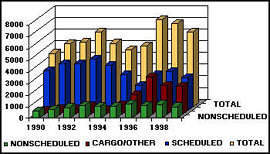
 AIRCRAFT MOVEMENTS 1990 - 1999 AIRCRAFT MOVEMENTS 1990 - 1999 |
 PASSENGER TERMINAL INTERIOR PASSENGER TERMINAL INTERIOR |
 Departure Duty-Free Shop Public Concourse Departure Duty-Free Shop Public Concourse |
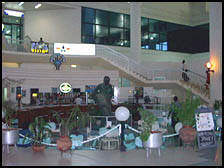
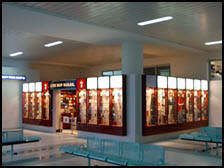
 DEPARTMENT OF CIVIL AVIATION ORGANOGRAM DEPARTMENT OF CIVIL AVIATION ORGANOGRAM |
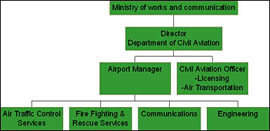
 CORPORATE STRATEGY CORPORATE STRATEGY |
.Continuous upgrading and expansion of airport and air traffic services and facilities and related infrastructure, as per user demand and international standards;
.Reorganisation and development of Flight Safety, Aviation Security and other areas of the Authority's activities in conformity with ICAO standards and recommended practices;
.Establishment of a seamless airport environment in partnership with all other service providers;
.Undertake vigorous marketing for the enhancement of traffic growth and the attraction of major carriers for the purpose of operating on-line hubbing activities with particular emphasis on the U.S. market;
.Diversify business activities and encourage private sector participation in the development of airport facilities and management of related infrastructure;
.Pursue an air transport liberalisation policy that will ensure respectable service standards with competitive charges whilst offering choice to customers, and
.Routinely network with airlines so as to encourage appropriate route development
 PHASE I-IV- INFRASTRUCTURE DEVELOPMENT COMPONENT PHASE I-IV- INFRASTRUCTURE DEVELOPMENT COMPONENT |
.Construction of a passenger terminal
.Construction of a single asphalt runway and aircraft parking apron to replace a landing strip consisting of perforated still plates (PSP)
.Installation of Airfield Lighting, basic Navigational aids and communication equipment,
.Lengthening of the single runway to e3600m
.Expansion of the apron to its existing size of 350m @ 127m
.Improvements to the Secondary Power Supply,
.Internal access roads, etc.
 AIRPORT MASTER PLAN AIRPORT MASTER PLAN |
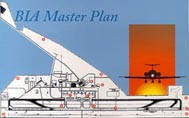
(click on image to enlarge 52Ko)
.Repairs/Rehab. Of Existing Taxiway & Apron D.6 million
.Extension of Apron & Construction of 2 new Taxiways D91.6 million
.Improvement of Power Supply; Procurement and Commissioning of a second 640 kva generator setD4.0 million
.Construction of a central sewage system D4.0 million
.New Fire Station, Fire Fighting & First Aid Equip and Hydrants and training: D2.1 million
.Replacement of airport perimeter fence D7.0 million
.Maintenance Yard & Building D1.0
.New Meteo Services D2.1 million
.New Control Tower Equipment, Radar and ASDE including Training D4.5 million
.New Headquarter Building D5.0 million
.Overlay of Runway D10 million
.Upgrading and expansion of road network D10 million
.Upgrading Management information system and set up of airport LAN/WAN D1.0 million
.Airfield Lighting and Equipment D2.0 million
.Electrical Works & Equipment D1.0 million
.First Aid Vehicles D7.0 million
.Tow Trucks and Bars D10 million
.Improvement of Passenger Terminal Facility D10 million
 THE NEW BANJUL INTERNATIONAL AIRPORT TERMINAL AND CONTROL TOWER THE NEW BANJUL INTERNATIONAL AIRPORT TERMINAL AND CONTROL TOWER |
.Construction cost: US$10million
.Inaugurated: 15th October 1997
.2-storey and 10,000m2 floor area
.Design Capacity: 1 million pax/yr
.Peak hour departing pax: 500
.Restaurants, Bar, Bank, Post Office, Tele-centre, CIPH, Duty-free and Bureau de Change
.FIDs, CCTVs
.X-ray baggage and Passenger Screening Devices, Radios, etc
 SECURITY SCREENING - Cabin Luggage SECURITY SCREENING - Cabin Luggage |
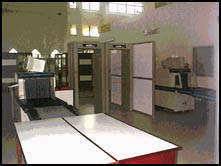
.Computerized Luggage Screening
.Metal Arch Detector
|
.Hand-held Metal Detectors
.Complete Backup System
.Physical Search Screening Room
.Sufficient Security personnel
 ICAO VOLUNTARY SAFETY AUDIT RECOMMENDATIONS, 1996 ICAO VOLUNTARY SAFETY AUDIT RECOMMENDATIONS, 1996 |
.Amendment and legislation of the Gambian Civil Aviation Act, 1991, explicitly providing for the establishment of a Civil Aviation Authority and its responsibilities, including specific responsibilities of the Director General that will empower the GCAA to give effect to the Chicago Convention;
.Development of adequate regulations and procedures to enable the GCAA implement international SARPS contained in Annexes 1,6, and 8;
.Consider ratification of Article 83 bis which provides for the delegation of functions between the State of Registry and the State of Operator;
.Finalise the Flight Operations, Personnel Licensing and flight Safety Directorate in such a way that it can function appropriately and recruit and train the necessary additional personnel; etc.
 PROGRESS ON SAFETY OVERSIGHT REMEDIAL PLAN, 1999 PROGRESS ON SAFETY OVERSIGHT REMEDIAL PLAN, 1999 |
.Revised, updated, and brought in to force the Civil Aviation Regulations;
.Drafted a new Civil Aviation Bill to be enacted as the revised CA Act;
.Established Personnel Licensing, Airworthiness and Flight Inspection systems;
.Developed appropriate handbooks and manuals; and
.Significantly improved staff recruitment and training.
 AVIATION SECURITY DEFICIENCIES, 1992 AVIATION SECURITY DEFICIENCIES, 1992 |
.The in-conducive nature of physical airport infrastructure to the exercise of effective security;
.Absence of any aviation security legislation or clear procedure and effective practices;
.Inadequate resources and equipment for the provision and maintenance of appropriate security;
.Poorly trained, lowly remunerated and unmotivated security work force;
.Low level of security awareness of security staff and airport workers in general;
.Proliferation of security agencies with ill-defined roles leading to duplicity and conflict in functions; and
.Ineffective ID-Card system with poor access control.
 PROGRESS ON AVSEC REMEDIAL PLAN, 1999 PROGRESS ON AVSEC REMEDIAL PLAN, 1999 |
.National, Airport and Airline security programmes had been prepared,
.The ID-Card system (for people and vehicles) was overhauled with the aid of a computerised system and access control tightened,
.100% x-ray screening of baggage was being carried out,
.Basic and recurrent training for all security staff was coupled with routine security drills,
.The FAA approved integrated computerised training system, SAFE PASSAGE, was being utilised,
.An Airport Emergency/Contingency plan was drafted,
.Security management was overhauled and strengthened and appropriate evaluation and reporting procedures put in place,
.There was clear delineation in the roles and responsibilities of the various security agencies, and inter-agency co-operation achieved, and outstanding air law instruments such as the Protocol for the Suppression of Unlawful Acts of Violence at Airports Serving International Civil Aviation and the Convention on The Making of Plastic Explosive, were ratified and ascended to.
 SECURITY SCREENING - Hold Baggage SECURITY SCREENING - Hold Baggage |
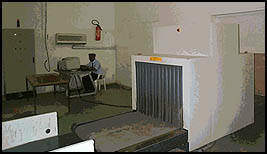
.Computerized Baggage Screening
.CCTV Surveillance
.100% Screening
.Accessible to authorized personnel only
 SAFE PASSAGE - FAA Approved Integrated Computerized Training Equipment In Use SAFE PASSAGE - FAA Approved Integrated Computerized Training Equipment In Use |
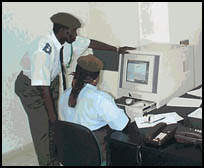
 SECURITY MANAGEMENT STRUCTURE SECURITY MANAGEMENT STRUCTURE |
see graph
 RECENTLY RATIFIIED PROTOCOLS RECENTLY RATIFIIED PROTOCOLS |
.Article 83 bis Montreal, 6/10/80
.Article 3 bis Montreal, 10/5/84
.Article 56 Montreal, 6/10/89
.Article 50(a) Montreal, 25/10/90
.Convention on the International Recognition of Rights in Aircraft Geneva, 1948
.Convention on Damage Caused by Foreign Aircraft to Third Parties on the Surface Rome,7/10/52
.The suppression of Unlawful Acts of Violence at Airports Serving International Civil Aviation, Montreal 23rd September 1971
.Making of plastic explosives for the purpose of detection, Montreal 1st March 1991
 SIGNING OF OPEN SKIES AGREEMENT - USA - GAMBIA 2nd May 2000 SIGNING OF OPEN SKIES AGREEMENT - USA - GAMBIA 2nd May 2000 |
 Banjul Accord Group of Member States Banjul Accord Group of Member States |
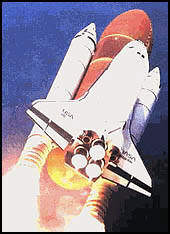
.Cape Verde
.Gambia
.Ghana
.Guinee Bissau
.Liberia
.Nigeria
.Sierra Leone
 BANJUL ACCORD STRUCTURE BANJUL ACCORD STRUCTURE |
BIA - Good Enough For The Space Shuttle
Space Shuttle Takes Off - BIA Serves As Its Emergency Landing Site
 EXPORT PROCESSING ZONE - Selected Sites EXPORT PROCESSING ZONE - Selected Sites |
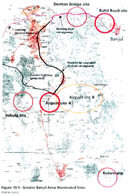
(click on image to enlarge 154Ko)
.Airport
.Bund Road
.Denton Bridge
.Kuloro
.Salagee
 EXPORT PROCESSING ZONE - Airport Sites EXPORT PROCESSING ZONE - Airport Sites |
.160 ha or 1,600,000 m2 Existing: Radville; vegetable and Farm Produce Exporter. Proposed: Light Industries e.g. Labelling, packing & repacking, reshipment, Agro-industrial processing units, warehousing and storage, etc.
.An additional 3700 ha zone from airport zone to Lamin and extending to the river front making a total of 5,000 ha or 50sq. Km.
|

